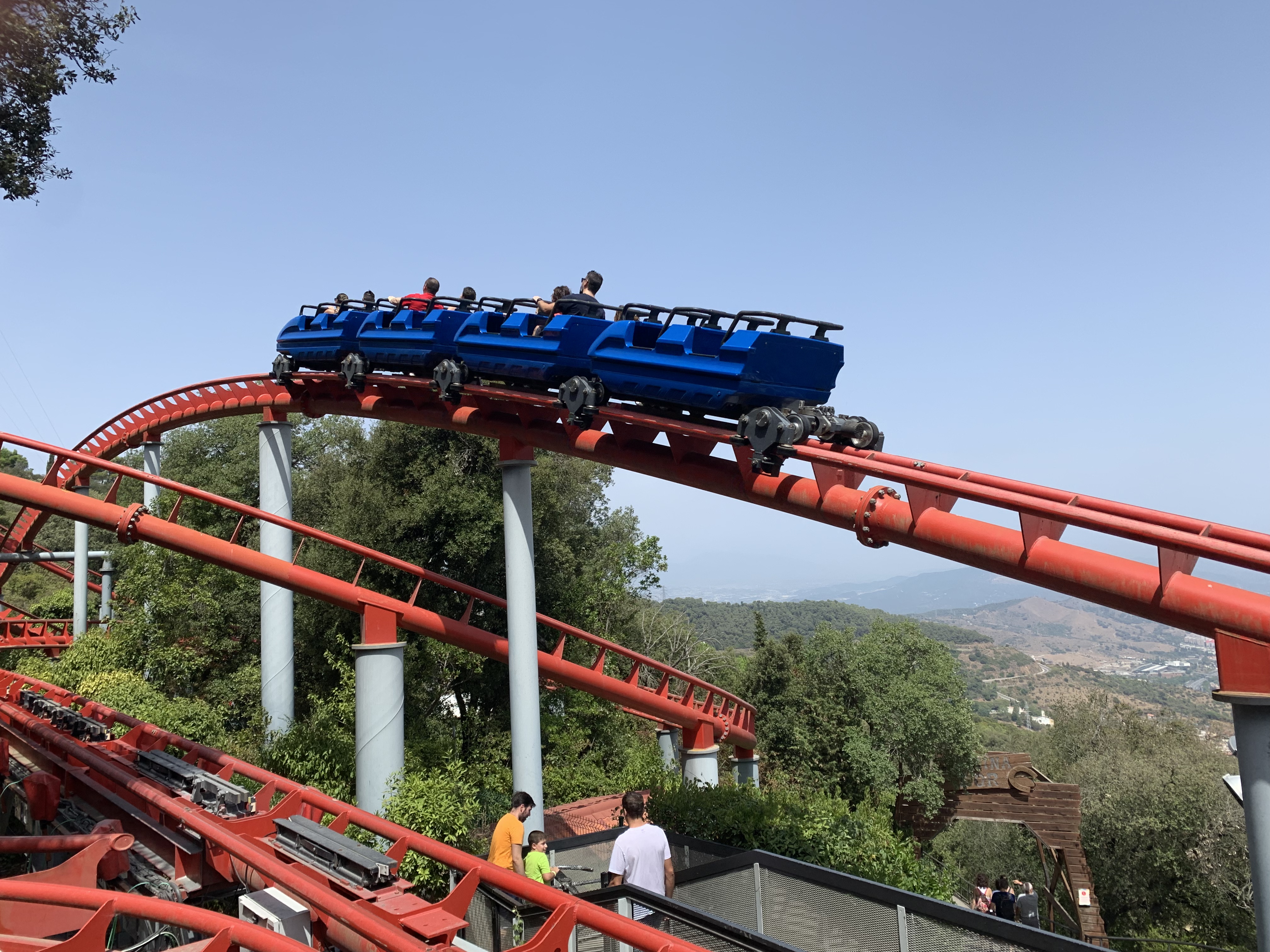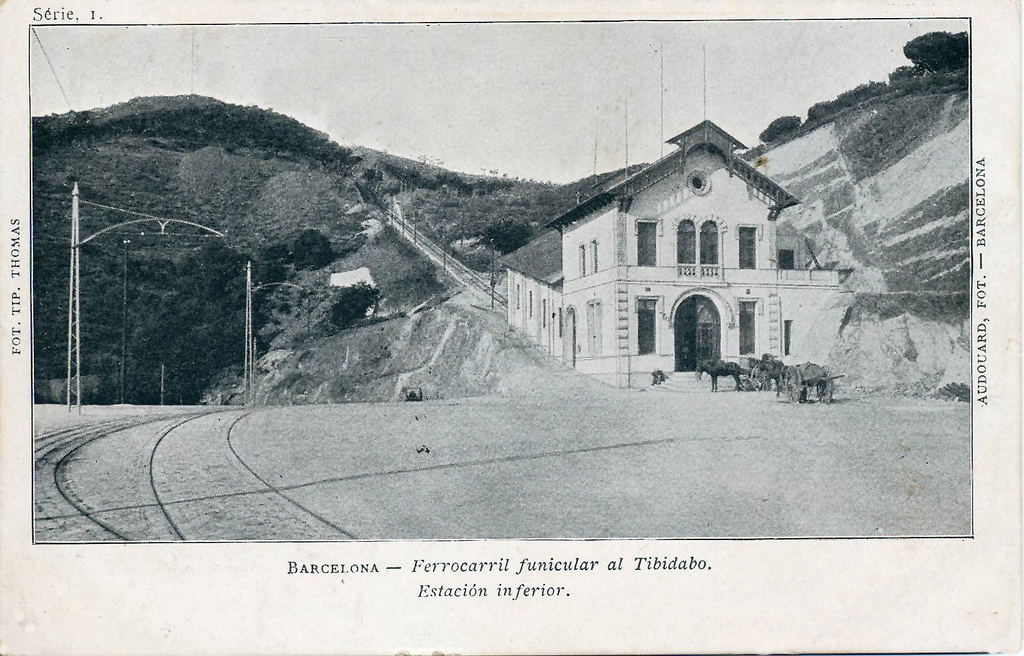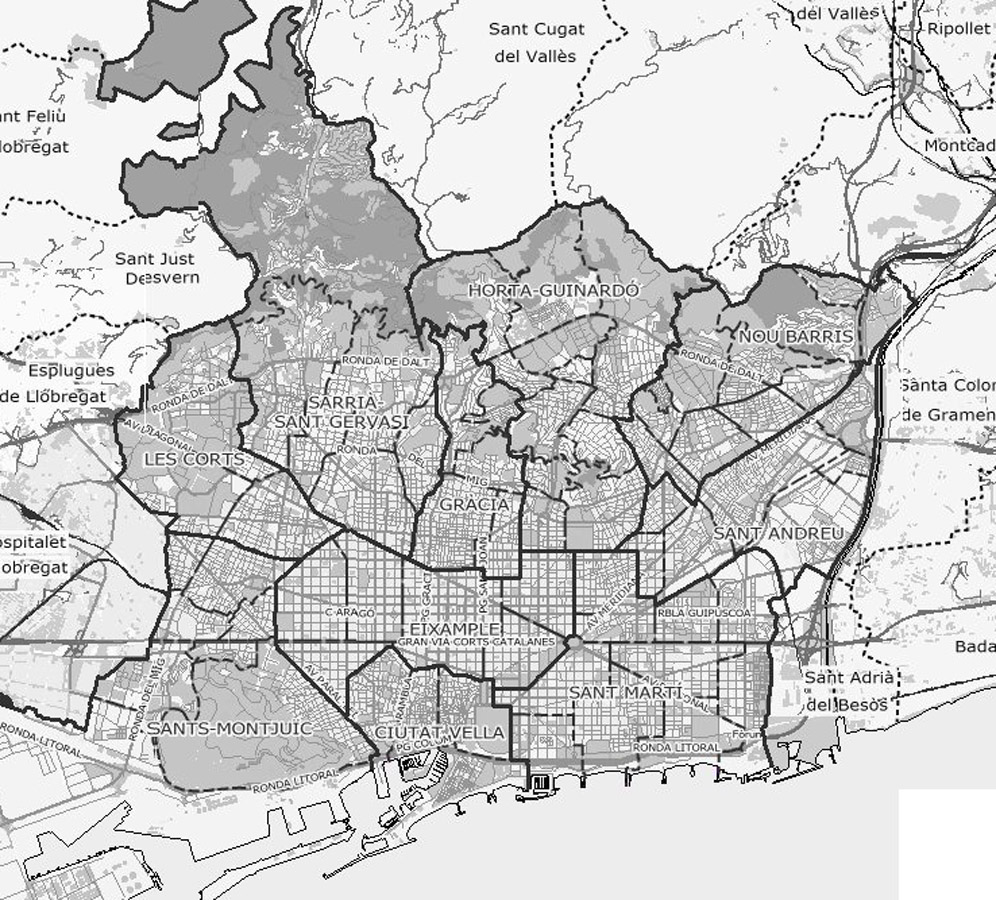|
Tibidabo
Tibidabo () is a hill overlooking Barcelona, Catalonia, Spain. At , it is the tallest hill in the Serra de Collserola. Rising sharply to the north-west, it has views over the city and the surrounding coastline. The summit of the hill is occupied by the Temple Expiatori del Sagrat Cor, Sagrat Cor church and adjacent Tibidabo Amusement Park. The Torre de Collserola, Torre de Collserola telecommunications tower is a short walk away. All three are prominently visible from most of the city of Barcelona. Designed by Enric Sagnier, the church was started in 1902 and took 60 years to complete. It is topped by a sculpture of the Sacred Heart of Jesus by Josep Miret Llopart. Tibidabo can be reached by road or via the Tibidabo Funicular, which was the first of its kind in Spain, and by the Tramvia Blau. Funicular operations recommenced in June 2021 after modernisation, however the tramway remains out of service. Replacement bus TC2 connects Tibidabo with Avinguda de Tibidabo Metro station ... [...More Info...] [...Related Items...] OR: [Wikipedia] [Google] [Baidu] |
Tibidabo Amusement Park
Tibidabo Amusement Park ( Catalan: Parc d'Atraccions Tibidabo) is an amusement park located on Tibidabo in the Collserola Ridge in Barcelona. The park was built in 1899 by the entrepreneur Salvador Andreu and opened in 1905. The park is among the oldest in the world still functioning. It is Spain's longest running amusement park. Most of the original rides, some of which date to the turn of the 20th century, are still in use. The park is now owned by the Barcelona City Council. History An amusement park on the Tibidabo mountain was first proposed in 1899 by pharmacist Salvador Andreu, who envisioned a funicular, tram line, and amusement rides. Work formally began on the ''Tranvía Azul'' and funicular on June 16, 1900, with both being inaugurated by Barcelona cardinal Salvador Casañas y Pagés on October 29, 1901. The first amusement rides however weren't installed until 1905 – mostly smaller attractions such as binoculars, mirrors, automaton displays, and various games. Th ... [...More Info...] [...Related Items...] OR: [Wikipedia] [Google] [Baidu] |
Funicular Del Tibidabo
The Tibidabo Funicular (; ) is a funicular railway in the city of Barcelona, in Catalonia, Spain. The line connects ''Plaça del Doctor Andreu'', the upper terminus of the '' Tramvia Blau'', with the summit of Tibidabo, where there is an amusement park and a church, the Temple Expiatori del Sagrat Cor. The funicular is one of three in Barcelona, the others being the Funicular de Vallvidrera and the Funicular de Montjuïc. After modernisation works the funicular recommenced operations with new trainsets nicknamed "''La'' ''Cuca de llum"'' in June 2021 during a period of upgrade works from 2019. The ''Tramvia Blau'', along with a parallel bus service, provides a connection from Avinguda Tibidabo metro station. This is the terminus of line 7 of the Barcelona Metro The Barcelona Metro (Catalan language, Catalan and Spanish language, Spanish: ) is a rapid transit network that runs mostly underground in central Barcelona and into the city's suburbs. It is part of th ... [...More Info...] [...Related Items...] OR: [Wikipedia] [Google] [Baidu] |
Tramvia Blau
The Tramvia Blau () is one of Barcelona's three tram systems. It is a long heritage streetcar line serving a hilly area of the Sarrià-Sant Gervasi district between the terminus of FGC Barcelona Metro L7 and the Funicular del Tibidabo. The Tramvia Blau is operated by Transports Metropolitans de Barcelona (TMB) but it is not part of Autoritat del Transport Metropolità (ATM) integrated fare network. Tickets must be purchased from the tram conductor. The Tramvia Blau is one of only two first generation tramways to survive in Spain, along with the Tranvía de Sóller on the island of Majorca. It has been closed for reconstruction since spring 2018, with no known date scheduled for reopening. History The line was built at the instigation of Dr. Salvador Andreu, who was building a residential project around the axis of the Tibidabo Avenue, and was inaugurated in 1901. The line connected at ''Plaça Kennedy'' with trams of Barcelona's city system, but was independently owned. ... [...More Info...] [...Related Items...] OR: [Wikipedia] [Google] [Baidu] |
Urban Planning Of Barcelona
The urban planning of Barcelona developed in accordance with the History of Barcelona, historical and territorial changes of the city, and in line with other defining factors of public space, such as Architecture of Barcelona, architecture, urban infrastructure and the adaptation and maintenance of natural spaces, Parks and gardens of Barcelona, parks and gardens. The urban evolution of Barcelona has been constant since its foundation in Ancient Rome, Roman times to the present day, although since the nineteenth century it has been accentuated thanks to the Eixample, ''Eixample'' plan and the Municipal aggregations of Barcelona, aggregation of neighboring municipalities. Until the nineteenth century the city was constrained by its medieval walls as it was considered a military square, so its growth was limited. The situation changed with the demolition of the walls and the donation to the city of the fortress of the Citadel of Barcelona, Citadel, which led to the expansion of the c ... [...More Info...] [...Related Items...] OR: [Wikipedia] [Google] [Baidu] |
Enric Sagnier
Enric Sagnier i Villavecchia (; 1858 in Barcelona – 1931) was a Catalan architect. Although now not as well known as his contemporaries Antoni Gaudí, Lluís Domènech i Montaner and Josep Puig i Cadafalch, he was responsible for a number of landmark buildings, was very prolific, and could turn his hand to many styles, including Gothic Revival architecture, neo-Gothic, neo-Baroque and Modernisme, Modernista. He qualified as an architect in 1882, and one of his earliest works, together with Josep Domènech i Estapà, was the Palau de Justícia in Barcelona. Other well-known buildings by him in Barcelona are the la Caixa, Caixa de Pensions building in the Via Laietana, Barcelona, Via Laietana, the New Customs House (Duana) and the Sagrat Cor, church on the Tibidabo. Life and character Enric Sagnier was born in Barcelona on 21 March 1858, the son of Lluís Sagnier i Nadal, president of the La Caixa, Caixa d’Estalvis i Mont de Pietat de Barcelona (a bank), and Clementina ... [...More Info...] [...Related Items...] OR: [Wikipedia] [Google] [Baidu] |
Temple Expiatori Del Sagrat Cor
The Temple Expiatori del Sagrat Cor (; ) is a Roman Catholic church and minor basilica located on the summit of Mount Tibidabo in Barcelona, Catalonia. The building is the work of the Catalan architect Enric Sagnier and was completed by his son Josep Maria Sagnier i Vidal. The construction of the church, dedicated to the Sacred Heart of Jesus, lasted from 1902 to 1961. History The idea of building a Catholic church on the summit of the Tibidabo emerged in the late 19th century amidst rumors about the construction of a Protestant church and a hotel-casino at that location. This motivated a "Board of Catholic Knights" to acquire the ownership of the field and give it to Saint John Bosco in 1886, when he was visiting Barcelona at the invitation of Dorotea de Chopitea, a great patron and promoter of the project. From this arose the idea of a building dedicated to the Sacred Heart of Jesus, a dedication very popular at that time thanks to the impetus given by Pope Leo XIII, and foll ... [...More Info...] [...Related Items...] OR: [Wikipedia] [Google] [Baidu] |
Vallvidrera
Vallvidrera () is a neighbourhood of the Sarrià-Sant Gervasi district of Barcelona, Spain. It is situated in one of the sides of the Collserola hills, considered to be the lungs of the city due to the abundant forests it has. This wealthy neighbourhood has excellent views of the whole city, from some specific places and in a clear day it is possible to see Mallorca and the Pyrenees on the horizon. Although being a residential place it has important things such as, the Torre de Collserola (a communications tower designed by the architect Norman Foster), the Tibidabo Amusement Park and the Temple Expiatori del Sagrat Cor. Vallvidrera used to be a cool summer retreat where wealthy people from Barcelona had their summer houses. Now the wealthy live in this neighbourhood all year round and have their summer retreats in further places inside Catalonia, such as the Costa Brava The Costa Brava (; ; "Wild Coast" or "Rough Coast") is a coastal region of Catalonia in northeastern ... [...More Info...] [...Related Items...] OR: [Wikipedia] [Google] [Baidu] |
Casino Internacional Tibidabo
The Casino Internacional Tibidabo was a resort created in 1909 in Barcelona on the Tibidabo mountain. The building had a gaming room, theatre, and bar. The games of chance offered were klondyke, roulette and baccarat. Although gambling was forbidden by law in Spain Spain, or the Kingdom of Spain, is a country in Southern Europe, Southern and Western Europe with territories in North Africa. Featuring the Punta de Tarifa, southernmost point of continental Europe, it is the largest country in Southern Eur ..., the casino operated for three years until the government closed it down in 1912. Today the casino is part of an amusement park. The automatons museum occupies the premises of the old theatre. References {{commons category Casinos completed in 1909 Defunct casinos in Spain Demolished buildings and structures in Spain ... [...More Info...] [...Related Items...] OR: [Wikipedia] [Google] [Baidu] |
The Shadow Of The Wind
''The Shadow of the Wind'' () is a 2001 novel by the Spanish writer Carlos Ruiz Zafón and a worldwide bestseller. It is the first book in the series Cemetery of Forgotten Books. The book was translated into English in 2004 by Lucia Graves and sold over a million copies in the UK after already achieving success on mainland Europe, topping the Spanish bestseller lists for weeks. It was published in the United States by Penguin Books and in Great Britain by Weidenfeld & Nicolson and Orion Books. It is believed to have sold 15 million copies worldwide, making it one of the best-selling books of all time. Ruiz Zafón's follow-up, ''The Angel's Game'', is a prequel to ''The Shadow of the Wind''. His third in the series, '' The Prisoner of Heaven'', is the sequel to ''The Shadow of the Wind''. Plot summary The novel is actually a story within a story. The novel opens in the 1940s with the protagonist, Daniel, a boy whose father owns a bookshop in Barcelona. One day, his father takes ... [...More Info...] [...Related Items...] OR: [Wikipedia] [Google] [Baidu] |
List Of Mountains In Catalonia ...
This is a list of mountains in Catalonia, Spain. See also *Montserrat *List of mountains in Aragon References {{DEFAULTSORT:Mountains Of Catalonia Catalonia Mountains A mountain is an elevated portion of the Earth's crust, generally with steep sides that show significant exposed bedrock. Although definitions vary, a mountain may differ from a plateau in having a limited summit area, and is usually higher ... [...More Info...] [...Related Items...] OR: [Wikipedia] [Google] [Baidu] |
Serra De Collserola
The Serra de Collserola (), or simply Collserola, is a mountain range between the rivers Besòs (river), Besòs and Llobregat. It is part of the Catalan Coastal Range. These mountains separate Barcelona from the Vallès plain and their tallest peak is the Tibidabo, at 512 m. Other main summits are: Turó del Puig (Barcelona), Turó del Puig, Puig d'Olorda, Turó de Valldaura, Turó de la Magarola, Puig d'Ossa, and Puig Madrona. The valleys of the Llobregat and Besós Rivers, the plain of Barcelona, and the Vallès basin, mark the geographical boundaries of the Collserola massif. Collserola Park To preserve the area, in 1987 the Parc de Collserola (Collserola Park), which has an area of 84.65 km2, was established. It is one of the largest Parks and gardens of Barcelona, metropolitan parks in the world - 8 times larger than the Bois de Boulogne in Paris, and 22 times larger than Central Park in New York. In the park, over a thousand major plants and around thirty plant commu ... [...More Info...] [...Related Items...] OR: [Wikipedia] [Google] [Baidu] |







